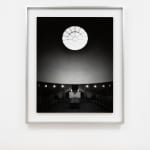



Hiroshi Sugimoto
58 1/4 x 46 7/8 inches
Further images
"Early-twentieth century modernism was a watershed moment in cultural history, a stripping away of superfluous decoration. The spread of democracy and the innovations of the Machine Age swept aside the ostentation that heretofore had been a signifier of power and wealth.I set out to trace the beginnings of our age via architecture. Pushing out my old large-format camera’s focal length to twice-infinity―with no stops on the bellows rail, the view through the lens was an utter blur―I discovered that superlative architecture survives the onslaught of blurred photography. Thus I began erosion-testing architecture for durability, completely melting away many of the buildings in the process."
- Hiroshi Sugimoto
Hiroshi Sugimoto turns the use of grey into a space of silence and contemplation, where shades of grey become an experience of time and memory. Fascinated by photography from an early age, Sugimoto went to study in the United States in 1970. His practice, spanning photography, architecture, installation, and scenography, investigates the passage of time and the evocation of atmosphere. The purity and sobriety of his images, drawn from the tradition of the ukiyo-e masters, rest upon a demanding technique: long, repeated exposures, subtle manipulations of light, and a restricted palette of greys that impart a singular depth to his prints.
Woodland Chapel (Eric Gunnar Asplund) (2001) stands as a key work for understanding Sugimoto’s approach, as it transcends the boundaries of architecture and photography to probe the notion of “conceptual form.” The exhibition “Dans le Flou” (April–August 2025) at the Musée de l’Orangerie, curated by Claire Bernardi, highlighted this subtle interface between blur and grey, presenting a work from the same series that concluded the exhibition path. Immersed in a grey sacrality that fills the space, our perception encounters a true sfumato: while the solemn, religious structure remains perceptible, its contours elude precise vision. The power of Sugimoto’s approach lies in this paradox: unable to apprehend a place with exactitude, we perceive its impressions, expanding the field of our sensibility, and rather than seeing it, we experience it.




